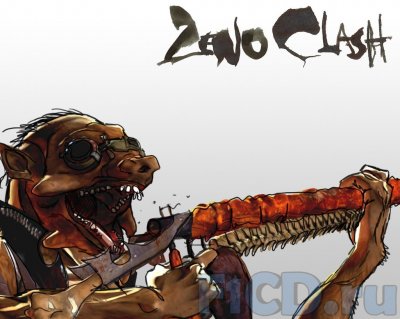 Review by Meho Krljic
Review by Meho Krljic
Zeno Clash
Developer Ace Team
Publisher Valve Corporation/ Noviy Disk
Released April 21, 2009
Available for PC
Verdict:  4/5 Thumbs Up
4/5 Thumbs Up
“If punching people in the face was this fun in real life no one would be taking heroin, going to college or playing videogames”
![]()
The Curse of Independence
In the past eighteen months or so, independent developers have finally managed to break into the mainstream. That indie games can be really good is not really news for those-who-know, but the ongoing shift of many major gaming companies (developers, publishers, platform owners) towards online software distribution has so far yielded several great results. Namely where games like Cave Story or Warning Forever still remain cult classics reserved for gamers to whom the notion of independence retains ideological qualities, games like Braid or World of Goo have become authentic hits in a much wider population with major exposure in most of the specialised media and very positive feedback from the industry professionals and customers alike.
All is not peaches and cream in the indiedevelopmentland. Time will tell whether existing distribution channels and economies attached to them can actually feed all the mouths sucking at the digital teat. If Jonathan Blow of Braid fame is to be trusted (and nothing suggests he should not be trusted), even though he made healthy profit with his game, the existing business model of Microsoft’s Xbox Live Arcade service makes it impossible to profit on a game if the team making it exceedes four people. Braid was made using one and a half person, whereas World of Goo had essentially three people working on the game.
Where does that put the developers of Zeno Clash, small Chilean company Ace Team is anybody’s guess. Zeno Clash was made by a group of nine people and the team is currently hoping to have a chance to port the game to Xbox Live Arcade as sticking to one platform only in these doom-and-gloom-and-global-recession-times seems less wise with every passing day. However, the amount of work necessary to port the code to another platform and fulfil all Microsoft’s licensing requirements might end up being too much for the team to actually profit from it.
It is a conundrum of a sort that one would rather not solve. Essentially, you want to do what you love – make beautiful, original games, but the question is, even with all the publishing and distribution shortcuts modern technology grants you, can you actually feed yourself and your family by doing what you love.
The question is even more complex when you are making the said game in Chile, a country certainly lacking infrastructure and support that even the bedroomest of bedroom coders in the North America or Western Europe or Japan can take for granted. If you have a look at Ace Team’s messageboard you will see that the game development was funded from personal savings and loans, which makes it as independent (and suicidal) as it gets. Because, when you look at it, Zeno Clash is NOT your typical indie game.
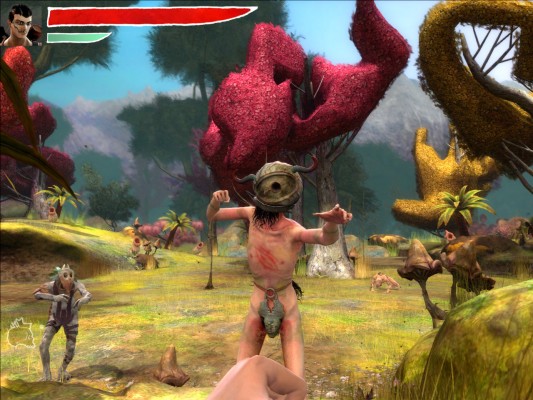 Yes, Braid and World of Goo are both fantastically good games with production values several orders above the indie average. But Zeno Clash is a first person action game with proper story, voice acting, and cutscenes, all made by nine people.
Yes, Braid and World of Goo are both fantastically good games with production values several orders above the indie average. But Zeno Clash is a first person action game with proper story, voice acting, and cutscenes, all made by nine people.
It’s like, how do you even decide to do a game like that on a budget that consists of your life savings and wide eyed hopes? I mean, I don’t want to get all teary eyed and speak about personal sacrifices and stuff, but, seriously, that a bunch of people in Chile sat down and made Zeno Clash is a testament to pure love for the medium. It’s a game made without calculation and ulterior motives, a game that embodies the sense of wonder every one of us had as a child when we were only starting to dabble in gaming. It’s a game of adventure, action and brutal violence set into a world bursting with originality and… vision.
So… Zeno Clash managed to make several splashes in the indie development community, turning heads everywhere with its unique art style and sheer bravery of even going down the first person route. It was pronounced ‘The Best upcoming Indie’ at last year’s Mod of the Year awards and was nominated for excellence in visual art at this year’s Independent Games Festival. When it finally made it out of the gate it was greeted with an avalanche of cheers, great reviews from almost everyone who is someone and exploding enthusiasm from the fan community.
And yet, we still don’t know if the developers actually managed to break even so far. If they didn’t and if by the end of human history they don’t, this will be remembered as a textbook example of the fact that Universe is after all a cynical bastard. That or that the gaming industry is indeed so far down the path of such utmost decadence that it will take nothing less than a whole new Great Videogame Crash to produce any semblance of hope.
It’s not just that Zeno Clash is a beautiful, imaginative piece of interactive art (or at least is full of beautiful, imaginative artwork and ideas). It’s that we are talking about a game that, at the end of the day gives you what games should be giving you all the time: sheer pleasure of immersing yourself in gameplay so deep that you stop controlling the character on screen and become the character in the game world, your body becoming his virtual body, his anger and pain becoming your anger and pain.
First Personality
Making Zeno Clash a first-person game is what put such developmental and financial strain on the developers. 3D assets are brutally expensive and developing a modern-looking three dimensional environment takes obscene amount of time and manpower. Not to mention that first person games are essentially a benchmark for the quality of computer graphics as a whole at any given moment in our contemporary history (which is, of course absurd, but let’s get into it at another time) so every new game that doesn’t look like it could take Crysis in a fair fight will be laughed at by the cruel Internet denizens and declared an epic fail from the word go by their retarded cousins.
And yet, making Zeno Clash a first-person game is exactly what makes it so original and immersive.
Let’s talk about it for a moment. Yes, everyone can see how first person games are immersive. We are long past the times of abstract, rigid first person games that were harsh geometrical environments asking the player to do most of the work in her or his head. After Doom, Quake, Half-Life, after Thief and Counter Strike, after Condemned, Crysis and Left 4 Dead it’s pretty clear to anyone why first person can not really be replaced with anything else when you talk about immersion. This is the only type of gaming where the player is essentially inside the game, eyeing and hearing only those things that his digital avatar can see and hear. It is a powerful immersion technique and when done well it provides the player with unparalleled experiences closest in their nature to lucid dreaming. Or LSD, whichever comes first.
So, Zeno Clash is an action game in the first person, but it is not a first person shooter (although it has some shooting), nor it is a first person sneaker (and, to be honest, it doesn’t contain any sneaking whatsoever). Zeno Clash is a rare beast because it is a first person brawler, a whole game devoted to fistfighting in the first person.
Getting your knuckles all hot and bothered in the first person is not exactly unheard of. Games like Chronicles of Riddick, Condemned, Dark Messiah of Might and Magic, even Oblivion all contained melee fighting in various proportions, sometimes with spectacular results (as opposed to many other first person games where melee fighting was… a bit shit). But Zeno Clash is a game where for almost the first time in human history the main focus of the game is on brutal, sweaty fistfights in the first person and where the mechanics, level design and even artwork were all made around this concept. In other words: Zeno Clash is a game where you actually feel like you are actually fighting a person in front of you, concussions, bloody knuckles, shortness of breath and all, rather than a game where you feel like controlling a floating camera with strange ‘limbs’ protruding from its sides upon pressing buttons. Chalk one up for the home team.
World of Zoo
It’s easy to recognise how different and original Zeno Clash is because its setting and story are very much unlike anything you can buy on a shelf in any videogame store. Zeno Clash takes place in the land of Zenozoik, a colourful, psychedelic place where strange creatures dwell. The developers describe this world using the words ‘punk fantasy’ and this is indeed the best way to approach it. Because Zenozoik is, without a doubt a fantasy world and yet there’s precious little debt to Forgotten Realms or Tolkien on display here. You won’t find any elves or orcs in Zenozoik and magic is replaced by gunpowder and weaponised human and animal bones.
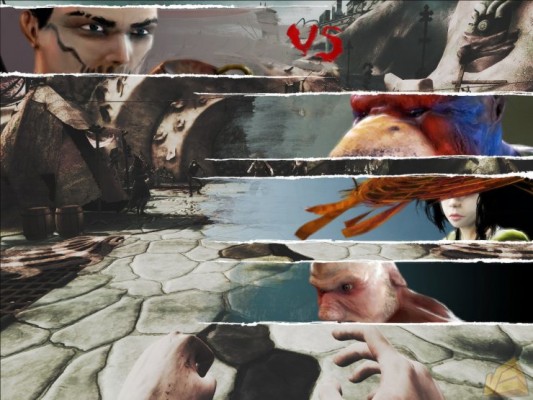 Neither is this a traditional low-fantasy world. Zenozoik manages to escape the usual fantasy tropes by being a mishmash of motives and ideas, closer to something Richard Corben would dream up in one of his powerful comicbook journeys on the pages of Heavy Metal (or some of his European counterparts in Metal Hurlant) than to any ‘modern’ fantasy world.
Neither is this a traditional low-fantasy world. Zenozoik manages to escape the usual fantasy tropes by being a mishmash of motives and ideas, closer to something Richard Corben would dream up in one of his powerful comicbook journeys on the pages of Heavy Metal (or some of his European counterparts in Metal Hurlant) than to any ‘modern’ fantasy world.
Zenozoik is a place where pig-faced humanoids live side by side with ‘normal’ humans, where gigantic saurian beasts (with names like Mucalosaurus) share screen time with firearms made of wood and bone, where grenades are made of human skulls. There are towns in Zenozoik – the town of Halstedom hosts part of the game’s storyline and is a psychedelic, strange place like something Jabba the Hutt would come up with fantasising about a low tech Wild West world – and there are wastelands in Zenozoik. There are dangerous nihilistic cultists dwelling in the countryside and then there are lonely, wise men who speak in riddles and walk around with Rubik’s cubes in their hands. The sole parent of the game’s protagonist is a birdfaced hermaphrodite creature called Father Mother. And s/he is murdered at the beginning of the game.
Zeno Clash starts its storyline in the middle and then mixes flashbacks with present time storytelling to explain why its protagonist, a young man named Ghat decided to kill Father Mother, rebel against the family and run away into the wild, while his brothers and sisters, oblivious to his motives chase after him, hungry for revenge and punishment.
Zeno Clash’s story could be described as sparse but this is not to say it is shallow. On the contrary, it deals with strong human emotions and is a mystery of sorts, motivating the player to go on and look for answers. There is a sense of doom, of the end of an era in the air, a sense of betrayal, break up with the status quo, a sense of maturity landing on the protagonists’ shoulders unwanted and unwelcome but still there and still unavoidable.
Ghat is not your typical videogame hero. Or anti-hero for that matter. He is a young, strong man who stumbled upon a terrible secret and whose life, as a result will never be the same. He is a dark eyed, dark haired, soft spoken person with face paint and leather clothes who spends most of the time in the game punching the living snot out of other people, usually his siblings, members of strange countryside cults or street gangs of Halstedom.
Ghat is an angry person. Not in a videogamey kind of way where terribly overdone melodramatics are regularly confused for proper human emotion. Ghat is angry in a very real way, angry because he knows his life so far has been a lie and his anger makes him go through people standing in his way like a ton of bricks attached to a pack of hungry Dobermans.
Ghat does not have a plan or even an agenda. He just wants to get away from the lie he used to call life, while his family just wants to catch and punish him for the crime he committed apparently without a motive. It’s a classical tragedy setting where no one is truly evil but no one is truly innocent either. The only person trusting Ghat to do right, unconditionally and without asking questions is Deadra, a young girl whose romantic attachment to the hero is clear from the first moments of the game, yet the narrative never descends into the pits of melodramatic clichés so common in videogaming.
Deadra is accompanying Ghat for most of the game and serves as a sidekick and motivation to continue telling the story. She is Zeno Clash’s equivalent of Half-Life 2’s Alyx, albeit in a compressed, stripped down form. (The stripped down part should be taken literally as she wears much less clothes than Alyx, yet never feels trapped inside of a sexist stereotype.)
There are other characters. Father Mother. Gang leaders. Mysterious assassin going under the moniker of Hunter. A combat teacher. A strangely godlike giant called Golem who hints at the metaphysical background of Ghat’s journey.
Symbolically it all fits together nicely and the game tells a story that can be analysed and discussed on different levels. On the face of things, it looks quite simple, yet it is obvious that there is much left unspoken, hinted at, hidden. Ghat is not your everyday hero but he indeed is special. His determination is heroic even though his actions are not. His heroic quest, that staple of fantasy storytelling is actually an anti-quest, an attempt to escape not only the responsibility for his actions but also the deceit of his life-so-far. Ghat is a renegade, but a true one, a renegade without and agenda, a rebel without a cause noble in his abandon of the set of values he now knows is based on a lie. This nobility is clearly visible as it is clearly visible that the events in this game are merely a setup for something much bigger that will happen in future. In future Zeno Clash games, if we’re lucky.
One more thing worth noting is how the game approaches killing. Usually, videogames are pretty casual about murder because it’s pretence and stuff but this game, despite the fact that it is one of the most convincingly brutal titles you are likely to play this year, is very serious about it, down to the fact that hardly anyone dies in it. Yes, it can be done.
If at First You Don’t Succeed, Punch the Sucker HARDER!!!!1!1!
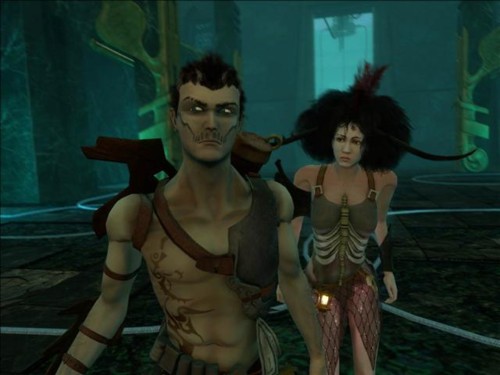 Even though the narrative and artistic elements of Zeno Clash suggest that this will be a game of exploration and adventure, this is not really true. The team wanted to make a game that allows freedom to the player, freedom to explore, freedom to evolve, but early on realised they simply do not have enough money or assets to do so. Therefore, after testing the model on a prototype game called Zenozoik (never released), Ace Team made the right set of choices, shaping Zeno Clash as a linear action game. Of course, the looks of the game are seductive and it is hard to play it without wanting to step over the fences limiting your movement to the open country, but the game itself doesn’t suffer for its narrow focus.
Even though the narrative and artistic elements of Zeno Clash suggest that this will be a game of exploration and adventure, this is not really true. The team wanted to make a game that allows freedom to the player, freedom to explore, freedom to evolve, but early on realised they simply do not have enough money or assets to do so. Therefore, after testing the model on a prototype game called Zenozoik (never released), Ace Team made the right set of choices, shaping Zeno Clash as a linear action game. Of course, the looks of the game are seductive and it is hard to play it without wanting to step over the fences limiting your movement to the open country, but the game itself doesn’t suffer for its narrow focus.
Because, as we said, Zeno Clash is not a shooter. If it was, its strict corridor nature would have been a problem. However, a game that demands close physical contact with the adversaries can be successfully built around a set of corridors and carefully constructed set pieces and actually profit from it.
For the four to six hours it takes one to complete Zeno Clash on the first playthrough, the player will be lead down fantastically designed locations, have the opportunity to fight insects and huge lizards using firearms, as well as to kick innocent chickens around. The main part of the game will of course be the fights between Ghat and many people trying to stop him and this is where Zeno Clash shines. Of course, the shooting and talking parts in the game are welcome because they vary the pace a bit and make it a richer experience, but without a doubt, Zeno Clash is played because of the brutality and mayhem that are its fistfights.
In the beginning, Ghat will be facing individual adversaries or small groups, but by the end of the game fighting four to five enemies will be a pretty normal occurrence. The combat system in the game is simple enough to be intuitive and natural, yet deep enough to allow for careful tactical approach to fighting.
It is necessary too, because Zeno Clash can be quite difficult if you think you can just tap the left mouse button repeatedly and finish the game. There are combat games that we describe using the words like ‘elegance’ or ‘ballet’ but Zeno Clash is not one of them. Zeno Clash is a brawler in the purest sense of the word, a mean, sweaty game where sounds of bone beating on flesh make your pulse hit the ceiling, a game where you fight dirty, punching people when they aren’t looking and kicking them while they try to get up from the ground. It is definitely (and defiantly) a non-hippie game. It is closest to being in an actual fistfight and still not having any bruises to show for it.
Zeno Clash allows the player to alternate between quick and strong punches, to string simple combos together, to block and dodge attacks coming Ghat’s way. Combat is well designed with intuitive visual cues and a natural economy to it: there are health and stamina to take care of which means fighting is as much about being the smartest guy in the arena as it is about being the toughest. Firearms can be used to tip the balance into one’s favour but they demand smart, tactical use because you cannot block when carrying and advanced combat techniques are unavailable when your arms are occupied. Skull bombs, funny looking explosive devices made of human skulls can be used for crowd control, yet it is advisable to remember the stick always has two ends and it is not uncommon to end up at the wrong end of one.
Zeno Clash is not a game patronising lazy gamers. It won’t give you magical sixth sense or the immersion-breaking ‘radar’ in the corner of the screen. You see what Ghat sees, you hear what Ghat hears. Yes, you will be attacked from the back more than once. Yes, you will be kicked to the ground and laughed at by people you didn’t hear approaching. Yes, you will learn to get your back against the wall when fighting groups of enemies, just like in real life. You will curse. You will block and dodge and wait for the moment to punch through the bastard’s block, so you can grab his clothes and knee him in his face, savagely. You will laugh maniacally when your enemies walk into your carefully prepared superstrong punches that will launch them into the nearest wall. Should you have a firearm on you, you will most probably pull it out while they try to get up and plant a slug or two into their bodies, sending them back to the ground. Rinse and repeat because it feels so good, brother.
This might be a shocking discovery for our inner hippies, but Zeno Clash is all about getting those hippies to curl their lips to the back, display their teeth and show wave after wave of people stupid enough to walk into their punching distance that before there were hippies, beasts used to live here. Zeno Clash is about getting physical like Olivia Newton John and then some, burning that goddamn urban ennui in the jet stream of adrenaline running through your veins. It is about fighting and winning in the purest sense of the word. Oh, and at certain points you get to use clubs and big huge hammers to bring down larger boss characters. Clubs. Hammers. Man, I am in love. Did I mention the combination of dash and elbow attack that is perfect for introducing yourself to new enemies?
The combat is varied enough to keep it from becoming stale and yet it never strays too far from its savage, primal core. Bossfights are imaginative and fun, especially the aforementioned Hunter who uses long-range firearms and… er… an army of parachuting, exploding squirrels. The final showdown in Halstedom is brutal, fun and emotionally fulfilling.
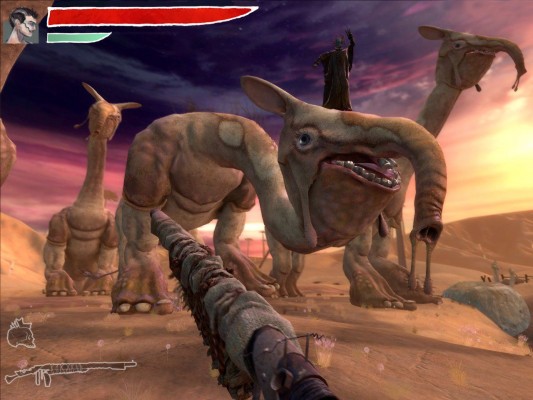 But it’s not like this is a perfect game. You could probably demand more variation in its boss fights and more elaborate firefights, but then you’d be a dick not taking into consideration what kind of a game Zeno Clash is. What still does not feel completely satisfactory is the lock-on mechanism and the firearms management that combine for some clumsy moments when fighting groups of enemies. The team has improved this part of the game through patches after taking in the comments from posters on their messageboard and, while not perfect, it feels much more convenient now. The game is still being regularly updated and this means that an already very functional system is getting better with every patch. Still, do not go in expecting that the game will adapt to your ideas of fighting. Zeno Clash has an old skool feel about it, the sense of a challenge that has as much to do with its controls and visuals as it has with the overall balance and you need to get better at it as the time passes, or you will never complete it.
But it’s not like this is a perfect game. You could probably demand more variation in its boss fights and more elaborate firefights, but then you’d be a dick not taking into consideration what kind of a game Zeno Clash is. What still does not feel completely satisfactory is the lock-on mechanism and the firearms management that combine for some clumsy moments when fighting groups of enemies. The team has improved this part of the game through patches after taking in the comments from posters on their messageboard and, while not perfect, it feels much more convenient now. The game is still being regularly updated and this means that an already very functional system is getting better with every patch. Still, do not go in expecting that the game will adapt to your ideas of fighting. Zeno Clash has an old skool feel about it, the sense of a challenge that has as much to do with its controls and visuals as it has with the overall balance and you need to get better at it as the time passes, or you will never complete it.
Afterglow of a Fistfight
When you do complete it, you can go ahead and do the Challenge Towers. Essentially a survival mode, this is a progression of arenas with specific types of enemies in each and is mad fun because it spoonfeeds you a steady stream of spectacular fights without having to make pit-stops for storytelling. The first big update for the game also provided the support for Garry’s Mod with tons of new models, skins and assets and if you’re really insatiable, there’s the official Zeno Clash web comic to observe. No, there is no multiplayer and, yes, people have been screaming and begging for at least online co-op in some of the future updates. Yes, me too. Because Zeno Clash, excellent as it is, could be spectacularly improved by going through it (or at least its challenge towers) with a friend (or at least an ally). You know it makes sense. This game is practically the first ever successful modern reinterpretation of games like Double Dragon and Final Fight, it has the same sense of brutal, focused mano-to-mano action and could be only made better by adding more warm bodies to the carnage.
If Looks (and sounds) Could Kill
Made on the Valve Company’s Source engine, Zeno Clash is a living, breathing proof that you don’t need bleeding edge technology to make stunning graphics. Yes, the polygon count is lower than what you get in Unreal 3 games and there is none of those fancy modern lighting tricks contemporary games pull out of their arse every time you begin to think that their gameplay could use some life in it. But the game still looks surreal and beautiful due to its inspired art direction. The authors cite John Blanche and Hieronymus Bosch as primary sources of inspiration but them being Chilean it is impossible not to drag Alejandro Jodorowsky into the equation. And maybe, just a little, classical Hong Kong kung-fu cinema. I mean, come on, every fight is announced with a screen showing the adversaries’ portraits and it can not but make your heart pump blood faster and harder each time.
More importantly, it looks lovely but it works well. Source, for all the good it did to Valve’s own games, spelled a bloody disaster for the first non-Valve game it was powering. Vampire the Masquerade: Bloodlines was a fantastic game that looked like vomit most of the time, missing its textures left, right and centre and bleeding assets into your RAM until you couldn’t even take a step without freezing the whole game for half a minute. Five years later and Source works very well for Zeno Clash. There are occasional bugs, crashes and clipping through the scenery but the game, ironically, is notably more stable than most mainstream products using comparably complex graphics.
The music in Zeno Clash is good enough to be sold separately and I still hope it will be. Voice acting, amazingly sounds very well most of the time, even though majority of it was done by the developers themselves. Yes, even the accents sound just right, at least to my ears.
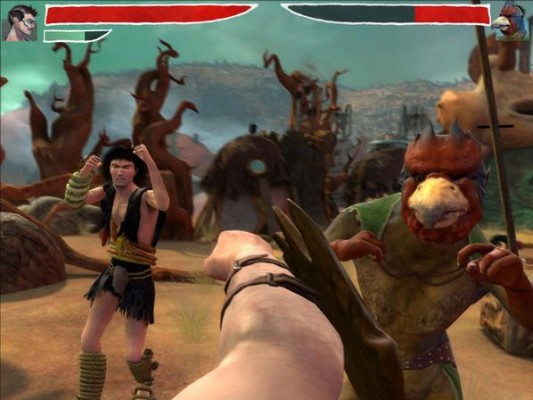 All in all, you wouldn’t confuse Zeno Clash for the latest Electronic Arts’ blockbuster, its production values are simply not that high, but what it sets out to do it does majestically. Released through Steam and Direct2Drive and sold for measly ten dollars, Zeno Clash is a game that can not afford advertising. In its stead it must rely on word of mouth and people’s will to promote the game to their friends because it’s just so good.
All in all, you wouldn’t confuse Zeno Clash for the latest Electronic Arts’ blockbuster, its production values are simply not that high, but what it sets out to do it does majestically. Released through Steam and Direct2Drive and sold for measly ten dollars, Zeno Clash is a game that can not afford advertising. In its stead it must rely on word of mouth and people’s will to promote the game to their friends because it’s just so good.
Ace Team was aware of this from the very start and to illustrate just how honest and open their approach to their own labour of love is, one should remember that one of the developers, Carlos Bordeu took the time to address people sharing the game on several major warez sites on the Internet, explaining that the team self-funded the game, that they neither can nor would attempt to stop the piracy, but encouraging the downloaders to purchase the game if they like it. Not only that Ace Team’s messageboard now boasts more than a handful of posters explaining how this kind of attitude motivated them to first try and then buy the game, but it was positively heartwarming seeing how hardened pirates carefully reposted the developer’s message everywhere the game was shared. It almost make one believe that human race can be saved.
Even if it can not, the immediate future looks somewhat bright. Despite the Ace Team still not confirming that the game made profit (but then again, it’s been only about month and a half since it was released and, being a non-advertised, online distributed indie game, its revenue trajectory will necessarily be different to the usual blockbusters that make most of the money in the first weeks after release) the announcement of a sequel has been made. Normally, we could frown at the fact that everyone these days just wants to milk established franchises, indie people included, but Zeno Clash 2 was practically begging to be made, whatwith the depth and potential the world and the story of the original have. The sequel will, if all goes well, have open ended gameplay, exploration and RPG elements which all sounds like this punk fantasy fable might have a proper happy ending after all. ![]()
![]()
Minimum System Requirements (PC):
o Operating System: Microsoft® Windows® XP / Vista / Vista64
o Processor: Intel® Pentium® 4 3.0 GHz
o Memory: 1 GB RAM
o Hard Disk Space: At least 3 GB of free space
o Video Card: 128 MB, Shader model 2.0, ATI 9600, NVidia 6600 or better
o Sound Card: DirectX® 9.0c compatible sound card
o DirectX® Version: DirectX® 9.0c, DirectX® 10
Reviewer’s System:
o Operating System: Microsoft® Windows® XP
o Processor: AMD Athlon 5000+
o Memory: 4 GB RAM
o Hard Disk Space: sufficient
o Video Card: nVidia GeForce 9800
o Sound Card: some on board piece of junk
o DirectX® Version: DirectX® 9.0c


“Did I mention the combination of dash and elbow attack that is perfect for introducing yourself to new enemies?”
I found I enjoyed firing my weapon at a charging enemy, throwing that weapon when he started charging again to stagger him and THEN giving the elbow rush combo.
This sounds and looks like a blast. And you raise some really interesting points about the difficulties of independent development. I do hope it gets easier, what with Steam and the like; even if the indies are never big hits, they need to be out there pushing the medium.
Okay, I’m sold and as this sucker is on sale at Steam today, I’m happy too.